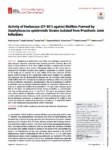Activity of Exebacase (CF-301) against Biofilms Formed by Staphylococcus epidermidis Strains Isolated from Prosthetic Joint Infections
Staphylococcus epidermidis is one of the main pathogens responsible for bone and joint infections, especially those involving prosthetic materials, due to its ability to form biofilms. In these cases, biofilm formation, combined with increased antimicrobial resistance, often results in therapeutic failures. In this context, the development of innovative therapies active against S. epidermidis is a priority. The aim of this study was to evaluate the in vitro activity of the lysin exebacase (CF-301) against biofilms formed by 19 S. epidermidis clinical strains isolated from prosthetic joint infections (PJI). We determined the biomass and the remaining viable bacteria inside biofilms after 24 h of exposure to exebacase. Exebacase activity was compared to that of rifampicin, vancomycin, and daptomycin. The use of exebacase in addition to antibiotics was also assessed. Exebacase displayed (i) a significant anti-biomass activity on S. epidermidis biofilms at concentrations ≥5 mg/L (mean decrease up to 66% at 150 mg/L), (ii) significant bactericidal activity on biofilms at concentrations ≥50 mg/L (mean decrease up to 1.7 log CFU at 150 mg/L), (iii) synergistic effects when used in addition to rifampicin, vancomycin, or daptomycin. The extent of these activities varied by isolate. Exebacase can be considered a promising therapy in addition to rifampicin, vancomycin, or daptomycin in the context of PJI. Further in vitro studies are needed to understand its mechanism of action on S. epidermidis biofilms and in vivo investigations are required to confirm these data.



